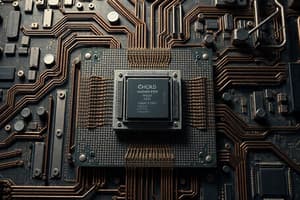Podcast
Questions and Answers
How did the transition from vacuum tubes to transistors impact the physical footprint and energy consumption of computers?
How did the transition from vacuum tubes to transistors impact the physical footprint and energy consumption of computers?
- Decreased size, decreased energy consumption (correct)
- Decreased size, increased energy consumption
- Increased size, increased energy consumption
- Increased size, decreased energy consumption
Consider a computer executing a program under the von Neumann architecture; what is the primary role of the Program Counter (PC) during this process?
Consider a computer executing a program under the von Neumann architecture; what is the primary role of the Program Counter (PC) during this process?
- To store the current instruction being executed.
- To buffer data moving between the CPU and main memory.
- To hold the memory address of the next instruction to be executed. (correct)
- To store the data being processed by the current instruction.
How did the introduction of stored programs, as seen in the von Neumann architecture, improve upon earlier computational methods?
How did the introduction of stored programs, as seen in the von Neumann architecture, improve upon earlier computational methods?
- By eliminating the need for any physical connections in the computer.
- By improving reliability with smaller components.
- By allowing faster processing speeds through the use of vacuum tubes.
- By enabling more flexible and automated computation without rewiring. (correct)
What was a significant operational challenge presented by First Generation computers that used vacuum tubes, impacting their reliability and maintenance?
What was a significant operational challenge presented by First Generation computers that used vacuum tubes, impacting their reliability and maintenance?
How does the Memory Buffer Register (MBR) contribute to data transfer within a computer system following the von Neumann architecture?
How does the Memory Buffer Register (MBR) contribute to data transfer within a computer system following the von Neumann architecture?
Why was the transition from machine language in the First Generation to assembly language in the Second Generation considered a significant advancement in computer programming?
Why was the transition from machine language in the First Generation to assembly language in the Second Generation considered a significant advancement in computer programming?
What distinguishes the function of the Memory Address Register (MAR) from that of the Memory Buffer Register (MBR) in a computer's memory operations?
What distinguishes the function of the Memory Address Register (MAR) from that of the Memory Buffer Register (MBR) in a computer's memory operations?
Considering the historical progression of computer storage mediums, what advantage did magnetic disks offer over magnetic tapes when they were introduced?
Considering the historical progression of computer storage mediums, what advantage did magnetic disks offer over magnetic tapes when they were introduced?
In computer architecture, what is the primary responsibility of the Control Unit (CC) within the von Neumann model?
In computer architecture, what is the primary responsibility of the Control Unit (CC) within the von Neumann model?
Integrated Circuits (ICs) marked a significant advancement in computer technology. What fundamental change did they bring about compared to using discrete components like transistors and resistors?
Integrated Circuits (ICs) marked a significant advancement in computer technology. What fundamental change did they bring about compared to using discrete components like transistors and resistors?
What role does the Instruction Buffer Register (IBR) play in the execution cycle of the IAS computer, and how does it contribute to processing efficiency?
What role does the Instruction Buffer Register (IBR) play in the execution cycle of the IAS computer, and how does it contribute to processing efficiency?
In the context of early computing history, which characteristic of the ENIAC most significantly limited the complexity and type of problems it could solve?
In the context of early computing history, which characteristic of the ENIAC most significantly limited the complexity and type of problems it could solve?
Consider a scenario where the address bus width of a computer system is increased. What direct impact would this have on the system's capabilities?
Consider a scenario where the address bus width of a computer system is increased. What direct impact would this have on the system's capabilities?
How did the architectural design of the IAS computer, particularly the format of its instruction word, contribute to its operational efficiency compared to earlier machines?
How did the architectural design of the IAS computer, particularly the format of its instruction word, contribute to its operational efficiency compared to earlier machines?
Flashcards
First Generation Computers
First Generation Computers
Characterized by the use of vacuum tubes.
Von Neumann Machine
Von Neumann Machine
A computer that stores both data and instructions in memory.
Program Counter (PC)
Program Counter (PC)
Holds the address of the next instruction to be fetched.
Transistors
Transistors
Signup and view all the flashcards
Moore’s Law
Moore’s Law
Signup and view all the flashcards
Instruction Buffer Register (IBR)
Instruction Buffer Register (IBR)
Signup and view all the flashcards
Disadvantage of First Generation
Disadvantage of First Generation
Signup and view all the flashcards
Arithmetic-Logic Unit (ALU)
Arithmetic-Logic Unit (ALU)
Signup and view all the flashcards
Magnetic tapes
Magnetic tapes
Signup and view all the flashcards
Integrated Circuits (ICs)
Integrated Circuits (ICs)
Signup and view all the flashcards
Memory Address Register (MAR)
Memory Address Register (MAR)
Signup and view all the flashcards
Assembly language
Assembly language
Signup and view all the flashcards
Memory Buffer Register (MBR)
Memory Buffer Register (MBR)
Signup and view all the flashcards
Machine language
Machine language
Signup and view all the flashcards
Control Unit (CC)
Control Unit (CC)
Signup and view all the flashcards
Study Notes
- These notes cover key concepts related to computer generations, architecture, and components
First Generation Computers
- Used vacuum tubes as their primary electronic components
- Programming was done using machine language
- Employed magnetic tapes for data storage
- ENIAC is an example and consumed approximately 140 kW of power
- The ENIAC weighed about 30 tons
- A key disadvantage was high heat production
Second Generation Computers
- Replaced vacuum tubes with transistors
- Assembly language was introduced
Third Generation Computers
- Utilized integrated circuits (ICs)
Computer Components
- ALU (Arithmetic-Logic Unit): Performs mathematical and logical operations
- MAR (Memory Address Register): Specifies the memory address for reading or writing data
- MBR (Memory Buffer Register): Temporarily holds data during transfers to and from memory
- PC (Program Counter): Holds the address of the next instruction to be fetched
- IR (Instruction Register): Holds the instruction being executed
- IBR (Instruction Buffer Register): Temporarily holds the right-hand instruction in the IAS computer
ENIAC
- Programmed using manual switches
- Could perform approximately 5,000 additions per second
IAS Computer
- Designed at the Princeton Institute for Advanced Studies
- Its memory stored both data and instructions in 40-bit words
- Instruction words contained two 20-bit instructions
- The opcode was 8 bits
Integrated Circuits (ICs)
- Combined components such as transistors and resistors
Moore’s Law
- Predicts the doubling of transistors on a chip
Transistors
- Smaller and more reliable compared to vacuum tubes
Von Neumann Architecture
- Introduced the concept of stored programs
- Allows a machine to alter its programs or internal data
- Includes the ALU as part of the Arithmetic-Logic Unit
- Control Unit is responsible for interpreting instructions
- Main memory stores both data and instructions
Studying That Suits You
Use AI to generate personalized quizzes and flashcards to suit your learning preferences.




